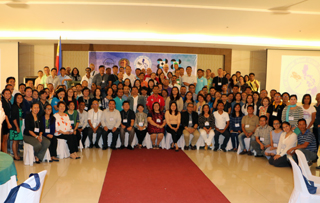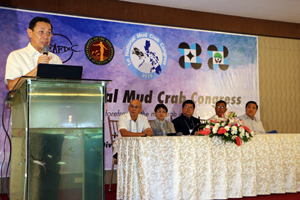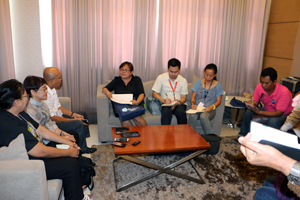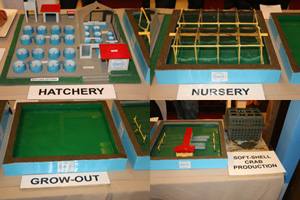 The Southeast Asian Fisheries Development Center – Aquaculture Department (SEAFDEC-AQD), in collaboration with the University of the Philippines Visayas (UPV) and the Philippine Council for Agriculture, Aquatic and Natural Resources Research and Development of the Department of Science and Technology (DOST-PCAARRD), recently held the first National Mud Crab Congress at Diversion 21 Hotel, Iloilo City.
The Southeast Asian Fisheries Development Center – Aquaculture Department (SEAFDEC-AQD), in collaboration with the University of the Philippines Visayas (UPV) and the Philippine Council for Agriculture, Aquatic and Natural Resources Research and Development of the Department of Science and Technology (DOST-PCAARRD), recently held the first National Mud Crab Congress at Diversion 21 Hotel, Iloilo City.
The congress, which had the theme, Philippines: In the forefront of the mud crab industry development, was led by Dr. Emilia T. Quinitio, program leader of the National Mud Crab S&T Program (NMSTP) and Dr. Adelaida T. Calpe, DOST-PCAARRD Industry Strategic S&T Program (ISP) Manager for Mud Crab.
Dr. Felix G. Ayson, SEAFDEC-AQD Chief, acknowledged PCAARRD and DOST’s support in the conduct of the NMSTP as well as the University of the Philippines Visayas (UPV) for being its partner in developing technologies for the mud crab industry. Ayson said that the technologies developed on soft-shell crab farming and mud crab hatchery technology, were already rolled out on a commercial scale.
 Inland Aquatic Resources Research Division (IARRD) Director Dalisay DG. Fernandez highlighted that with its production of 71,536 tons of mud crab in 2013 worth US$545 million, the Philippines is now a major mud crab producer, next to China.
Inland Aquatic Resources Research Division (IARRD) Director Dalisay DG. Fernandez highlighted that with its production of 71,536 tons of mud crab in 2013 worth US$545 million, the Philippines is now a major mud crab producer, next to China.
The Mud Crab Congress aimed to provide a venue to discuss the present state of the industry, latest developments and technologies, problems, issues, and researchable areas. It also sought to increase awareness and support for the industry, with the goal of making the country the biggest producer of mud crab.
At the congress, technologies on hatchery, nursery, grow-out, and postharvest of mud crab developed by scientists from SEAFDEC-AQD, UPV, other academic institutions, and private practitioners, were presented.
A workshop on the status and identification of research gaps and trainings needed on hatchery, nursery, grow-out, fattening, and aquasilviculture, and soft-shell crab production and postharvest was also held.
 Dr. Clarissa M. Marte of the Integrated Services for the Development of Aquaculture and Fisheries, Inc. of Iloilo City synthesized the workshop outputs during the closing ceremony. Participating state colleges and universities, SEAFDEC-AQD, UPV, and BFAR identified new research areas.
Dr. Clarissa M. Marte of the Integrated Services for the Development of Aquaculture and Fisheries, Inc. of Iloilo City synthesized the workshop outputs during the closing ceremony. Participating state colleges and universities, SEAFDEC-AQD, UPV, and BFAR identified new research areas.
At the open forum, the provincial and municipal governments cited ordinances that prohibit the collection and transport of certain sizes of crablets outside the municipality to conserve wild crab resources. With formulated local ordinances and availability of mature technologies on mud crab, roll out activities will benefit the mud crab industry.
 Dr. Fernandez, at the closing ceremonies, expressed appreciation to Tateh Feeds and other private practitioners for initiating research activities and sharing their information and significant findings during the congress. She also encouraged BFAR to get involved in the establishment of mud crab hatcheries and in the roll out of mature technologies. Finally, she emphasized that public and private partnership should be in place for the mud crab industry to move forward.
Dr. Fernandez, at the closing ceremonies, expressed appreciation to Tateh Feeds and other private practitioners for initiating research activities and sharing their information and significant findings during the congress. She also encouraged BFAR to get involved in the establishment of mud crab hatcheries and in the roll out of mature technologies. Finally, she emphasized that public and private partnership should be in place for the mud crab industry to move forward.
The activity ended with a group resolution renaming mud crab as mangrove crabs as well as a post conference visit of SEAFDEC AQD in Tigbauan Station, Dumangas Brackishwater Station and Igang Marine Station, and the University of the Philippines Visayas in Miagao, Iloilo, then followed.
A total of 246 participants from the academe, government agencies, non-government organizations, private sector, and media representatives attended the activity.
